ISSN ONLINE(2278-8875) PRINT (2320-3765)
ISSN ONLINE(2278-8875) PRINT (2320-3765)
K.Srinivas1, G.Srinivas2, Dr.K.Narasihma Rao3
|
| Related article at Pubmed, Scholar Google |
Visit for more related articles at International Journal of Advanced Research in Electrical, Electronics and Instrumentation Engineering
With the increasing of nonlinear loads in household application which may cause power quality issues at distribution end. In this paper, an analysis and simulation of a PV interactive shunt power active filter (SPAF) in single phase circuit. This system is used to eliminate harmonics generated by a nonlinear load. In the day-time with intensive sunlight, the PV interactive Shunt Active Filter system brings all its functions into operation. At night and during no sunlight periods, the power required by the loads is received from the distribution system while the inverter system only providesreactive power andfilter harmonic currents. For the Shunt Active Filter reference current computation. We used the instantaneous real and reactive current (Ip-Iq) algorithm and for gating signal generation we apply the hysteresis current control technique. The Simulation results (using MATLAB/SIMULINK) are presented and discussed. They show the effectiveness of the photovoltaic compensation system, the sinusoidal form of the current and the effectiveness of the reactive power compensation. The proposed solution has achieved a low THD (Total Harmonic Distortion), demonstrating the effectiveness of the presented method.
Keywords |
| pv cell, Shunt active power filter, current harmonics, Nonlinear load, reactive power |
INTRODUCTION |
| Harmonic currents are present in modern electrical distribution system caused from non-linear loads such as adjustable speed drives, electronic blast lightning, power supply of computer, fax machine and more of telecom equipment used in modern offices. The wide spread and growing demand of these loads greatly increased and the flow of harmonic currents on facilitated distribution system and has created a number of problems. These problems included over heated transformers, motors, conductors and neutral wire; nuisance breaker trips; voltage distortion, which can causes sensitive electronic equipment to malfunction or fail. |
| The need to generate pollution-free energy has starts considerable effort toward renewable energy (RE) system.RE sources such as wind, sunlight, and biomass offer the promise of clean and abundant energy. Among the RE sources, solar energy, is an attractive one. This useful energy is supplied in the form of DC power from photovoltaic (PV) arrays bathed in sunlight and converted into more convenient AC power through an inverter system.The photovoltaic arrays interactive shunt active power filter system can supply real power from the photovoltaic arrays to loads, and support reactive and harmonic power simultaneously to use its almost installation capacity. This technology has many excellent features and it causes little environmental burden, it is of a modular type technology that can be easily expanded, and it is applicable almost everywhere. This paper presents an analysis and simulation of a PV interactive Shunt Active Power Filter topology that achieves simultaneously harmonic current damping and reactive power compensation. Also, the inverter is always used to act as an active power filter to compensate the nonlinear load harmonics and reactive power. In the day-time with intensive sunlight, the PV interactive shunt active power filter system brings all its functions into operation. At night and during no sunlight periods, the power required by the load is received from the distribution system while the inverter system only provides reactive power compensation and filter harmonic currents. |
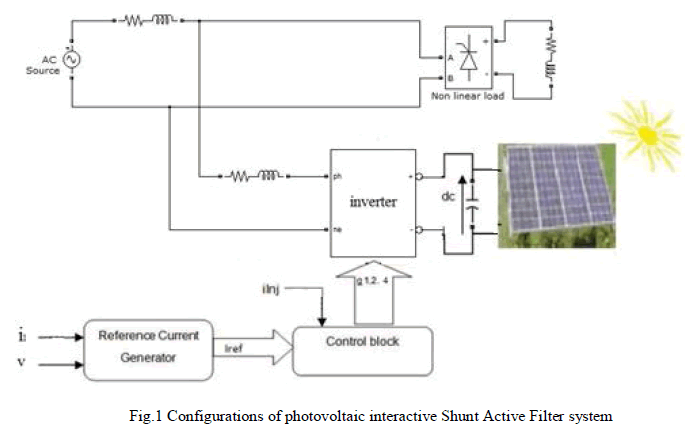 |
| The harmonics mitigation methods are line reactor, k-factor transformer, isolated transformer, tuned filter and active filter. Among active filter is the best method to mitigate the current harmonics. Because it can achieve harmonic distortion levels below 5% THD-I or less. Active filters can be used to reduce harmonic distortion levels below IEEE 519 -1992 standard guidelines .The shunt active power filter (SAPF) is a device that is connected in parallel to the power system. The performance of a shunt active power filter depends on many factors. Among them, the reference generation is the most important. The method to generate the reference template is responsible for the reference of currents that must be followed by an inverter current to produce the desired compensation currents that will mitigate harmonic currents generated by non-linear loads. Harmonic detection method will calculate the reference compensating currents. In this paper the instantaneous real and reactive current method (Ip - Iq) is used to generated the reference compensating current.From this reference compensating current the actual compensating current are generated with the help of hysteresis current controlled voltage source inverter.Hysteresis current controlled inverter will inject the compensating current into the power system. These compensating currents, will cancel the harmonics generated by nonlinear load. |
PV MODEL |
| A solar cell is basically a p-n junction fabricated in a thin wafer of semiconductor. The electromagnetic radiation of solar energy can be directly converted to electricity through photovoltaic effect. Being exposed to the sunlight, photons with energy greater than the band-gap energy of the semiconductor creates some electron-hole pairs proportional to the incident irradiation. To find the model of the photovoltaic generator, we must start by identifying the electrical equivalent circuit to that source. Many mathematical models have been developed to represent their highly nonlinear characteristics resulting from that of semiconductor junctions that are the major constituents of PVmodules. There are several models of photovoltaic generators which have a certain number of parameters involved in the calculation of voltage and current output. In this study, we will present the model of single diodes (Fig.2) taking into account the internal shuntand seriesresistances of the PV cell. |
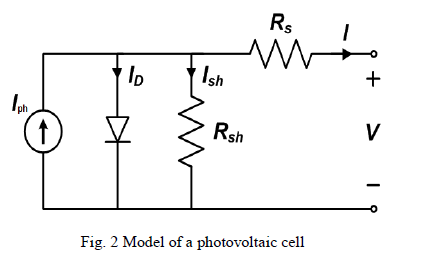 |
| The current source Iph represents the cell photocurrent. Rsh and Rs are the intrinsic shunt and series resistances of the cell, respectively. Usually the value of Rsh is very large and that of Rs is very small, hence they may be neglected to simplify the analysis.PV cells are grouped in larger units called PV modules which are further interconnected in a parallel-seriesconfiguration to form PV arrays. |
| The photovoltaic panel can be modelled mathematically as given in equations (1)- (4) |
| Module photo-current: |
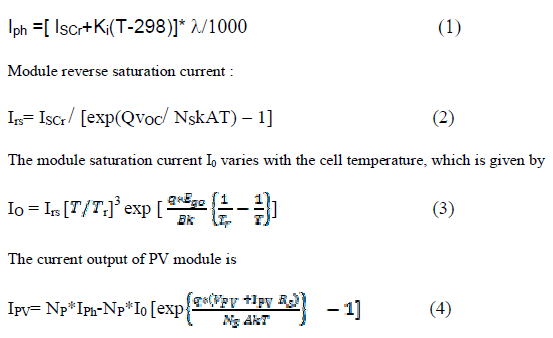 |
| Where Vpv and Ipv represent the output voltage and current of the PV, Iph is the photocurrent; IO are diode saturation current; q is coulomb constant (1.602 e-19C); Tris the reference temperature is 298 K;K is Boltzman’s constant (1.381e-23 J/K); T is cell temperature (K); NSare P-N junction ideality factor; Rshand Rsare the intrinsicshunt and series resistance of the cell respectively;Ns is the number of cells connected in series is 36 ;Np is the number of cells connected in parallel is 1 |
DETECTION METHOD BASED ON THE INSTANTANEOUSREAL AND REACTIVE CURRENT METHOD |
| The instantaneous reactive power theory is used to detect the harmonics here. The source voltage V(t)=Vsinωt, where V is the peak value of voltage. |
| The load distortion current consisting by fundamental and harmonic components is expressed by Fourier series |
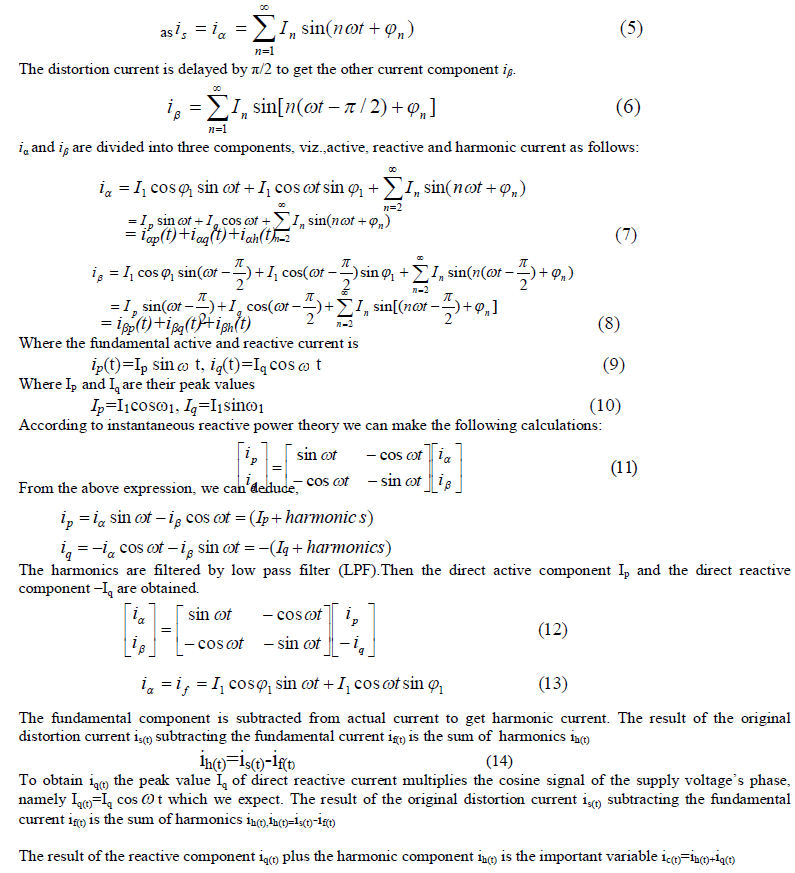 |
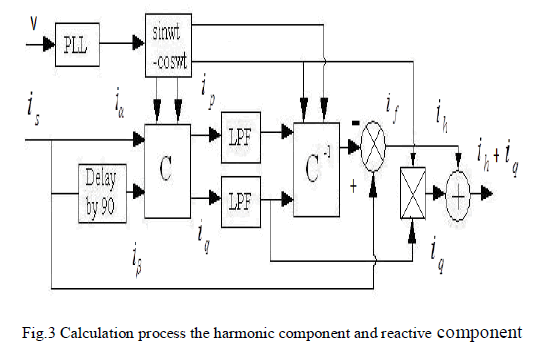 |
HYSTERESIS CURRENT CONTROLLER |
| Hysteresis current control method of generating the switching signal for the inverter switches in order to control the inverter output current. It is adopted in shunt active filter due to best among other current control methods, easy implementation and quick current controllability. It is basically a fed back current control method, where the actual current continuously tracks the reference current in the hysteresis band .the actual current with in this hysteresis band. The reference and actual current is compared with respect to hysteresis band which decides switching pulse of voltage source inverter. |
| As the current crosses a set hysteresis band, the upper switch in the half-bridge is turned off and the lower switch is turned on. As the current exceeds the lower band limit, the upper switch is turned on and the lower switch is turned off. |
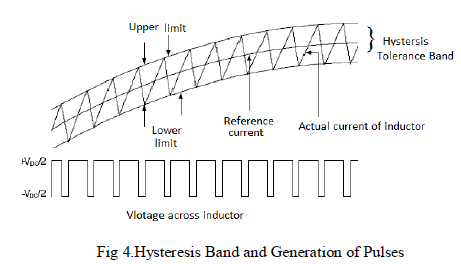 |
| Fig 4.The switching frequency depends on how fast the current changes from upper limit to lower limit and vic versa. This, in turn depend on voltage vd and load inductance |
SIMULATION RESULTS |
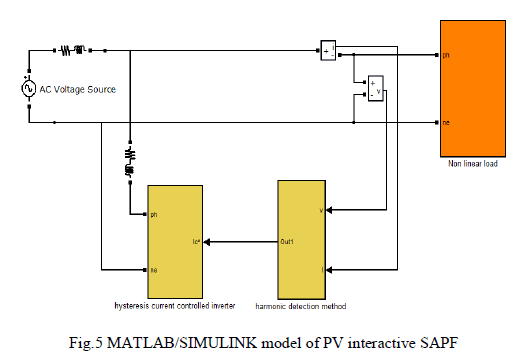 |
| Fig.5 The proposed model for a PV interactive shunt active power filter using harmonic detection method with hysteresis current controller has been successfully modelled and tested using MATLAB/SIMULINK toolbox |
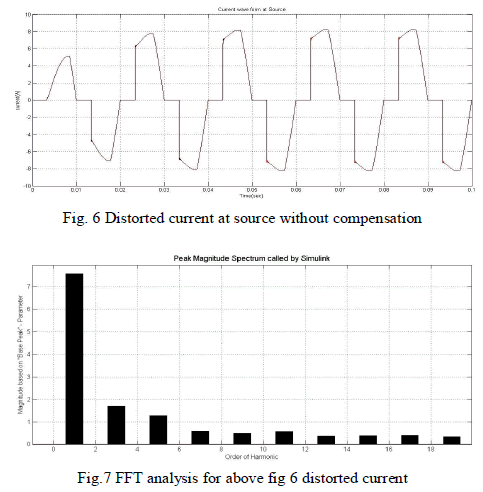 |
| Fig. 6 shows the distorted load currents of nonlinear load. Harmonic currents are injected into power system by nonlinear load. Because of harmonics source current will be distorted. For distorted current THD is 33% |
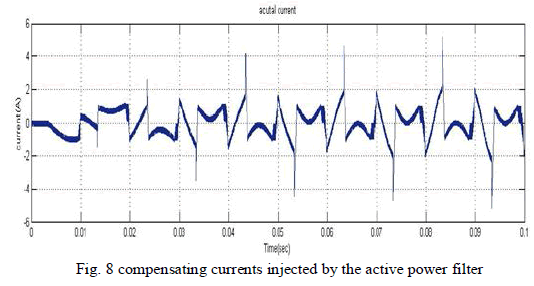 |
| Fig 8 the compensating currents injected by the shunt active power filter at the point of common coupling. |
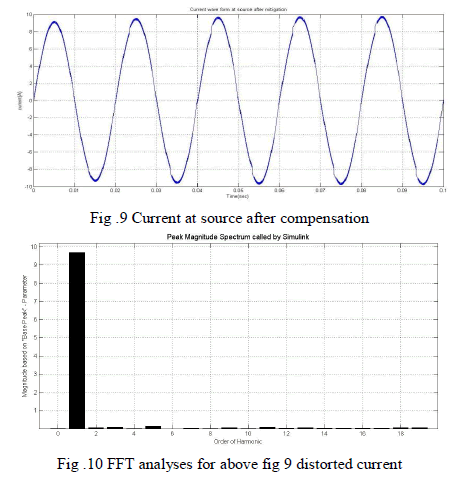 |
| Fig. 9 shows the supply or source currents after compensation current supplied by shunt active power filter. Compensating currents are injected into power system by SAPF. AS a result THD is reduced 33% to 2.1%.reactive power will decreased and power factor will improve. |
CONCLUSION |
| An PV interactive shunt active power filter is designed and the circuit is connected in parallel as it reduces the harmonic injection into the power system network due to nonlinear load. In this paper a current control strategy is presented for SAPF in single phase circuit. The proposed control algorithm is capable of reducing the harmonics in the limits of IEEE 519. After compensation, the source current is sinusoidal. It compensates harmonics present in the power system and the percentage of current THD values is reduced and reactive power will decreased and power factor will be improve. |
References |
|